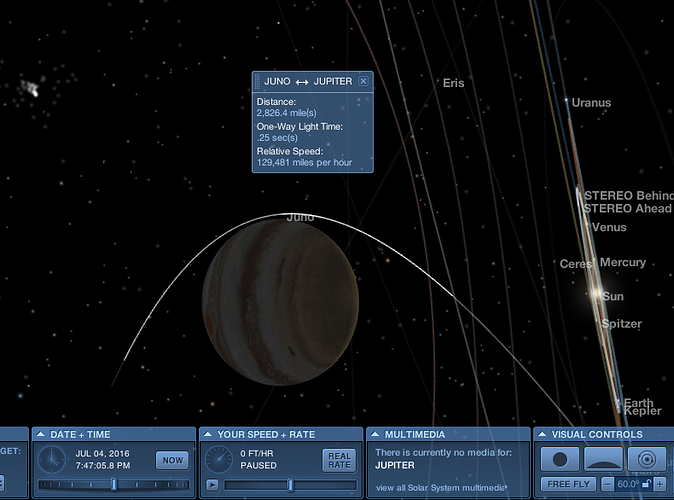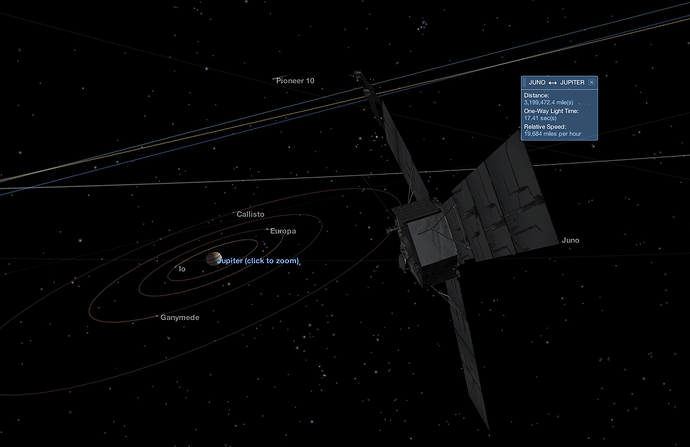This year, on the 4th of July (right around 7:47 pm West Coast time to be more precise) there will be a spacecraft hurtling over the North Pole and down to within 3,000 miles of cloud tops of the planet Jupiter. The tremendous gravity of our largest planet will accelerate this spacecraft to almost 130,000 miles per hour making it the fastest speed ever attained by a human-created thing. It will be the first of hopefully 37 orbits during which the instruments on board the spacecraft will dutifully take radiation, gravity and magnetic field measurements until the intense radiation from the planet fries them. The spacecraft is named Juno. I recently attended the May meeting of the Seattle Astronomical Society and listened to Ron Hobbs talk about the mission. Ron is a member of NASA’s ambassador program and relayed a talk by Scott Bolton the Principal Investigator for the Juno mission.
Image from the excellent NASA’s Eyes application. In this view the North Pole is to the right and you can see the Sun and the inner planets there in the background
I’ve been following Juno for a while now but Ron had some interesting things to say about it that I didn’t know:
LEGO!
Juno is the first (I think?) spacecraft to carry LEGO
](https://www.nasa.gov/sites/default/files/images/577171main_lego20110803-full.jpg)
These three LEGO figures are mounted on the side of Juno. On the left holding the lightning bolt is Jupiter, Roman King of the Gods. In the middle is the Goddess Juno, one of Jupiter’s wives. She holds a magnifying glass that she might pierce the veil of clouds to see Jupiter. On the right with a telescope in one hand and a model of the planet Jupiter in the other is the great scientist Galileo who was the first person to aim a telescope at the planet.
Earth Flyby
Juno has already done a planetary flyby. Back in 2013 it passed by the planet Earth (maybe you’ve heard of it). That’s right, Earth. When it was launched in 2011 its initial orbit took it out past the planet Mars but it came back and used the Earth’s gravity to boost it up into an orbit that took it above the plane of the ecliptic and on to its rendezvous with Jupiter.
As it passed Earth over the Southern Hemisphere near South Africa it took some images of Earth. The JPL posted a great video that you should watch. That isn’t an artist’s rendition. It’s actual footage of our Earth and Moon from space.
JunoCam
Juno’s scientific mission does not feature photography. It does have a very nice camera on board called JunoCam but it is not part of the scientific payload. It’s use will be in part determined by the public. You will be getting the opportunity to help decide what Juno should look at. There should be a lot of pretty pictures to see. In particular, we’ve never gotten a good look at the polar regions. The magnetic field around Jupiter is much more intense than ours here and as a result the auroras at the poles are very large and dynamic. Should be spectacular.
Measuring Gravity
Something I found fascinating is the gravitational measurement experiments. If a planet is perfectly smooth with all its stuff distributed evenly, we would expect anything in orbit around it would follow a similarly smooth path. But Jupiter (or any other planet for that matter) is not uniform. Some areas have clumps with more mass and others have less. This mass anisotropy will manifest itself as slight perturbations in the orbit of Juno and that’s what the scientists will be looking to measure. This will yield a map of the interior structure of the planet.
Radiation Aplenty
Because of the huge magnetic field around Jupiter Juno will be heading into some highly irradiated areas. The intensity of this radiation required that they house the instruments in a heavily shielded titanium box to keep them operating. Even so they are only expected to last about two years. Here is a graphic from NASA showing the entire suite of instruments.
](http://www.nasa.gov/images/content/567922main_junospacecraft0711.jpg)
It should be quite a show and I’m looking forward to seeing what happens this summer.

